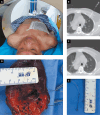Preoperative localization of pulmonary nodules: virtual bronchoscopic navigation vs a 4‑hook localization needle
- PMID: 40547834
- PMCID: PMC12177350
- DOI: 10.20452/wiitm.2025.17930
Preoperative localization of pulmonary nodules: virtual bronchoscopic navigation vs a 4‑hook localization needle
Abstract
Introduction: Both virtual bronchoscopic navigation (VBN) and puncture with a 4‑hook localization needle are viable methods for localizing pulmonary nodules. However, there is a paucity of research that compares these 2 approaches.
Aim: This study aimed to assess and compare the efficacy of and complications associated with these 2 approaches to pulmonary nodule localization.
Materials and methods: We analyzed 223 patients who underwent VBN (n = 98) or needle localization (n = 125) of pulmonary nodules between April 2020 and December 2022. Each study group was divided into 2 subgroups, namely the solitary‑nodule group and the 2‑nodule group. We collected and analyzed data on localization time, accuracy, success rate, and complications in each group.
Results: In the solitary‑nodule subgroup, the mean (SD) distance between the localization point and the pulmonary nodule was 6.2 (6.1) mm for the needle‑localization group and 8.6 (4.8) mm for the VBN‑localization group (P = 0.01). In the 2‑nodule subgroup, the mean (SD) distance did not significantly differ and amounted to 8.7 (4.6) mm for the needle‑localization group and 8.4 (4.4) mm for the VBN‑localization group. However, the mean (SD) time required for localization was shorter in the VBN‑localization group (17.2 [2.6] min) than in the needle‑localization group (26.6 [3.9] min; P <0.001), which indicated that VBN was more efficient in 2‑nodule localization. The solitary nodule- and 2‑nodule-localization procedures differed significantly in terms of complications, such as pneumothorax and bleeding, with fewer complications reported in the VBN‑localization group.
Conclusions: In comparison with needle localization, VBN localization was associated with fewer complications. In the case of 2 pulmonary nodules, VBN localization outperformed the needle approach, with shorter localization time, fewer complications, and no radiation exposure.
Keywords: 4‑hook localization needle; localization; pulmonary nodules; virtual bronchoscopic navigation.
Copyright © 2025 The Author(s).
Conflict of interest statement
Conflict of Interest: None declared
Figures


Similar articles
-
Shape sensing robotic assisted bronchoscopy versus virtual bronchoscopic navigation in the diagnosis of peripheral pulmonary nodules.Sci Rep. 2025 Jul 4;15(1):23950. doi: 10.1038/s41598-025-08798-2. Sci Rep. 2025. PMID: 40615493 Free PMC article.
-
Sertindole for schizophrenia.Cochrane Database Syst Rev. 2005 Jul 20;2005(3):CD001715. doi: 10.1002/14651858.CD001715.pub2. Cochrane Database Syst Rev. 2005. PMID: 16034864 Free PMC article.
-
Application of computed tomography-guided hook-wire localization technique in thoracoscopic surgery for small pulmonary nodules (≤ 10 mm).J Cardiothorac Surg. 2023 Apr 5;18(1):99. doi: 10.1186/s13019-023-02188-3. J Cardiothorac Surg. 2023. PMID: 37020219 Free PMC article.
-
Guided tissue regeneration for periodontal infra-bony defects.Cochrane Database Syst Rev. 2006 Apr 19;(2):CD001724. doi: 10.1002/14651858.CD001724.pub2. Cochrane Database Syst Rev. 2006. Update in: Cochrane Database Syst Rev. 2019 May 29;5:CD001724. doi: 10.1002/14651858.CD001724.pub3. PMID: 16625546 Updated.
-
Systemic pharmacological treatments for chronic plaque psoriasis: a network meta-analysis.Cochrane Database Syst Rev. 2021 Apr 19;4(4):CD011535. doi: 10.1002/14651858.CD011535.pub4. Cochrane Database Syst Rev. 2021. Update in: Cochrane Database Syst Rev. 2022 May 23;5:CD011535. doi: 10.1002/14651858.CD011535.pub5. PMID: 33871055 Free PMC article. Updated.
References
-
- Guidelines for management of incidental pulmonary nodules detected on CT images: from the Fleischner Society 2017. Macmahon H., Naidich D.P., Goo J.M. Radiology. 2017;284:228-243. - PubMed
-
- Video‐assisted thoracoscopic sur‐ gery for small indeterminate pulmonary nodules: indications for preoperative marking. Suzuki K., Nagai K., Yoshida J. Chest. 1999;115:563-568. - PubMed
-
- Comparative effectiveness and safety of preoperative lung localization for pulmonary nodules: a systematic review and meta‐analysis. Park C.H., Han K., Hur J. Chest. 2017;151:316-328. - PubMed
-
- Multicenter, prospective, observational study of a novel technique for preoperative pulmonary nodule localization. Fan L., Yang H., Yu L. J Tho‐ rac Cardiovasc Surg. 2020;160:532-5392. - PubMed
LinkOut - more resources
Full Text Sources
Miscellaneous
